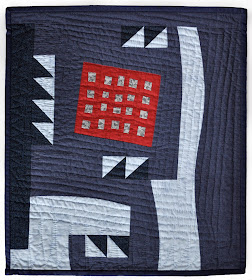Last night, one of my dreams - a dream I thought was an impossible dream - came true.
Back in 2002, I was visiting my godmother, Jackie Schneider, in New York City. She knew I liked quilts, so she told me to go to the Whitney Museum of American Art, where there was supposed to be a great quilt show. I was staying at the Four Seasons, and it was close enough to the Whitney, so I went over and checked it out. I had no idea what I was about to see. It was
The Quilts of Gee's Bend.
The only other quilt show I'd seen before was an exhibit called
Nineteenth-Century Applique Quilts at the Philadelphia Museum of Art in 1989. That show featured jaw-dropping masterpieces from the Museum's permanent collection, including the famous
Charlotte Gillingham Album Quilt from 1842-1843. Basically, that's the type of quilt I expected to see on display at a museum.
Boy, was I in for a surprise!
When I walked into the Whitney, the first quilt I saw was
Lutisha Pettway's "Bars" denim work clothes quilt, circa 1950. For a split second, I thought, "What is this?" followed immediately by "Oh my GOD! This is AMAZING!" It was a revelation. It changed everything. Even though the quilts had very humble origins, the vision was crystal clear. I was standing in the presence of very sophisticated works of art. The visual sophistication wasn't just academic, though. These were the most big-hearted quilts I'd ever seen.
 |
| Bible Story by Polly Raymond of Gee's Bend, Alabama. |
This week, noted author Kyra Hicks, a Facebook friend who I hope to meet in person one day, was selling some quilts on eBay. Kyra has written several wonderful books about African American quilts and quilt makers. One of the quilts she was selling was a Polly Raymond Bible Story quilt from Gee's Bend, and I was the lucky winner of the auction. Actually, lucky doesn't even begin to describe it.
Polly Raymond is one of seven daughters in a family of the ten children. Her mother is the irrepressible Lucy Mingo, who once participated in the Selma to Montgomery March for Civil Rights, aided by Dr. Martin Luther King, Jr. Speaking about the event, Mingo declared, "No white man gonna tell me not to march. Only make me march harder."
I love Lucy! And I haven't even met her yet.
Recently, I was telling Julie Silber of
The Quilt Complex that I would be speaking next summer at the Quilter's Affair in Sisters, Oregon, where the quilt makers from Gee's Bend will also appear as featured guests. Very big deal for me! I saw
Ricky Tims perform there last summer, and I thought, "One day, I want to be up on that stage." Julie told me if there's one person I need to meet, it is Lucy Mingo. If she's there, I will have her daughter's quilt with me, and I'll be waiting with open arms.
My godmother from New York, "Aunt Jackie" as I called her, passed away a few years ago. She was always one of my favorite people, but I don't think she ever realized how much her suggestion to go to the Whitney changed me. I wish I could just pick up the phone and call her.
Somehow, I feel like she was with me today.




















































